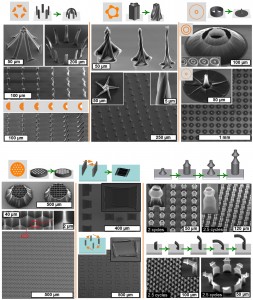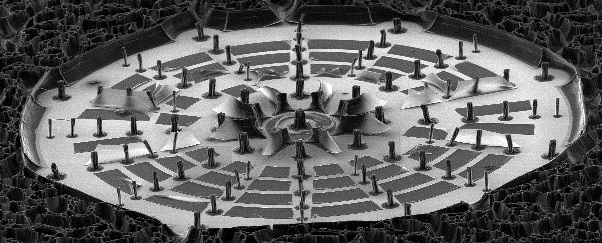 Surface textures with three-dimensional (3D) architectures demonstrate attractive ability to control interfacial, optical, chemical and mechanical properties. They have potential applications ranging from device scale bio-molecule sensing to meter scale optical or non-wetting coatings. In recent years, capillary forming rose as a versatile and scalable approach to creating complex geometries at the nano- and micron scales. Surface tension of a liquid (e.g. water) can deform straight pillars, and assemble them into 3D architectures with pre-determined orientation, where short-range adhesion forces stabilize the final forms. Capillary forming of CNTs is based on shape-directed capillary rise during solvent condensation; followed by evaporation-induced shrinkage. This process relies on understanding of the thermodynamics of condensation and evaporation, the kinetics of capillary rise within porous filamentary materials (here CNTs) and the mechanics of liquid induced stresses and plastic deformations of nanoporous microstructures. 3-D geometric transformations result from the heterogeneous strain distribution within the microstructures caused by the evolution of their initial cross section geometry during the vapor-liquid-solid interface shrinkage. These microstructures have very high mechanical properties due to reduction in the spacing among CNTs. Additionally, capillary forming process is a versatile framework for designing and fabricating 3-D multi-functional microstructures for a variety of applications including wetting and adhesion, and micro-electronic interconnects.
Surface textures with three-dimensional (3D) architectures demonstrate attractive ability to control interfacial, optical, chemical and mechanical properties. They have potential applications ranging from device scale bio-molecule sensing to meter scale optical or non-wetting coatings. In recent years, capillary forming rose as a versatile and scalable approach to creating complex geometries at the nano- and micron scales. Surface tension of a liquid (e.g. water) can deform straight pillars, and assemble them into 3D architectures with pre-determined orientation, where short-range adhesion forces stabilize the final forms. Capillary forming of CNTs is based on shape-directed capillary rise during solvent condensation; followed by evaporation-induced shrinkage. This process relies on understanding of the thermodynamics of condensation and evaporation, the kinetics of capillary rise within porous filamentary materials (here CNTs) and the mechanics of liquid induced stresses and plastic deformations of nanoporous microstructures. 3-D geometric transformations result from the heterogeneous strain distribution within the microstructures caused by the evolution of their initial cross section geometry during the vapor-liquid-solid interface shrinkage. These microstructures have very high mechanical properties due to reduction in the spacing among CNTs. Additionally, capillary forming process is a versatile framework for designing and fabricating 3-D multi-functional microstructures for a variety of applications including wetting and adhesion, and micro-electronic interconnects.
